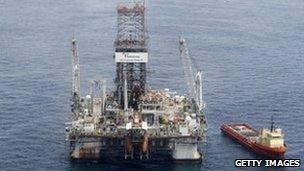Ships evacuated from Gulf as tropical storm advances
- Published
BP's Doug Suttles says the storm could delay plans by up to two weeks
Dozens of ships in the Gulf of Mexico are preparing to leave the site of the BP oil spill as Tropical Storm Bonnie gathers pace.
Incident commander Admiral Thad Allen said the well would remain capped while ships evacuated the Gulf.
Drilling on a relief well has been suspended for up to two weeks.
Bonnie is the second named storm of the 2010 Atlantic hurricane season, with wind speeds of 40mph (65km/h), the US National Hurricane Center says.
Forecasters say the edge of the tropical storm could reach the spill area by early on Saturday.
It has already caused flooding in Haiti, Puerto Rico and the Dominican Republic and is moving north-west over the Bahamas, according to the National Hurricane Center in Miami.
Many of the boats and drilling rigs responding to the oil spill were preparing to move to safety from Thursday night, said Adm Allen.
"This includes the rig drilling the relief well that will ultimately kill the well, as well as other vessels needed for containment," he said.
The operation to permanently block the well would be delayed, but "the safety of individuals at the well site is our highest concern," Adm Allen said.
Vessels were being positioned in a way that would allow crews "to promptly re-start oil mitigation efforts as soon as the storm passes," he added.
A "packer" - a plug used during storms - has been placed in the relief well to stabilise it while workers leave the site.
Earlier on Thursday, Adm Allen said increasing confidence in the security of a new cap placed on the leaking well had convinced scientists it would be safe to leave the capped well unmonitored for several days.
'Encouraged' by results
The damaged well was closed off eight days ago while tests were being carried out to see if there are weaknesses in the well or ruptures in the sea bed.

The Development Driller II has been drilling one of the two relief wells
White House spokesman Robert Gibbs said US Energy Secretary Steven Chu and other experts had been "encouraged" by the results so far.
Senior BP official Doug Suttles said a week with no new leakage had improved the situation on the surface, with skimmers picking up vastly reduced quantities of oil.
Skimming has gone from 25,000 barrels of oil a day before the cap was put on to just 56 barrels on Wednesday.
The government is to reopen one-third of the closed Gulf fishing areas, as oil has not been observed for 30 days.
Earlier, US President Barack Obama announced he would take his family on holiday to Florida's Gulf Coast for the weekend of 14 August.
'Static kill'
Permission for BP to test the well was conditional on seismic, acoustic and visual monitoring - all of which will stop during the evacuation of the site.
Chris Fawkes of the BBC Weather Centre looks at the course the storm may take
The first relief well is only 4ft from the damaged well horizontally, but more work needs to be done before it can be used for a "kill" to stop the flow permanently.
A final piece of casing needs to be cemented in place at the bottom of the relief well.
BP executive Kent Wells said on Thursday the oil giant had been given permission to begin preparing for "static" kill - pumping mud into the top of the well through the new cap - which is being viewed as an intermediate measure.
BP is awaiting final approval from Adm Allen on whether to move forward with the process.
Eleven workers on the BP-leased rig were killed when the Deepwater Horizon drilling rig exploded on 20 April and the oil has caused one of America's worst environmental disasters.
The New York Times has reported that a safety survey by the Lloyd's Register Group found pieces of equipment on the Deepwater Horizon Rig - which belonged to Transocean - had not been tested since 2000, despite guidelines recommending testing every three to five years.
A spokesman for Transocean said the company had an "unwavering commitment to safety" and the survey had found that the overall maintenance of the rig exceeded required standards.
